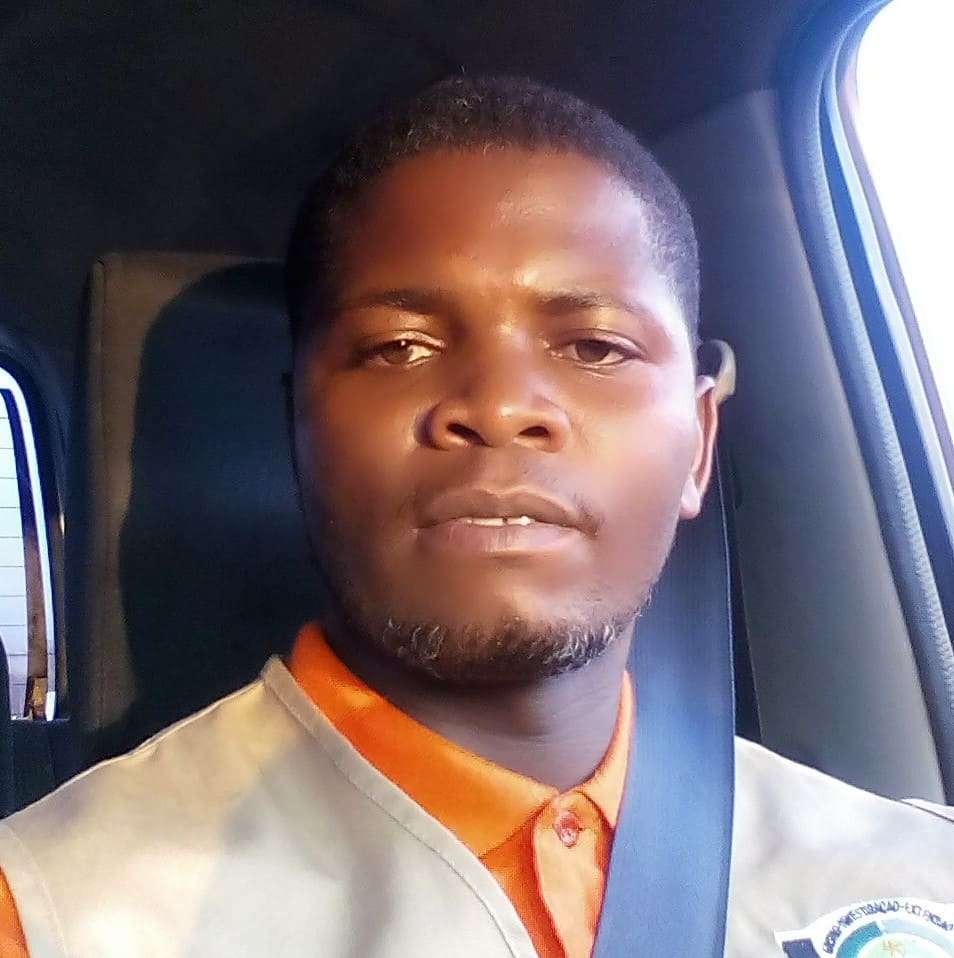ORIGINAL ARTICLE
MALENGUE, Abílio Santos [1]
MALENGUE, Abílio Santos. Raising awareness about Covid-19 in rural communities in the province of Huambo-Angola. Revista Científica Multidisciplinar Núcleo do Conhecimento. Year 06, Ed. 01, Vol. 07, pp. 05-16. January 2021. ISSN: 2448-0959, Access link: https://www.nucleodoconhecimento.com.br/health/rural-communities
SUMMARY
Named by the World Health Organization, COVID-19 was first discovered and identified in humans at the end of 2019 in a Chinese city of Wuhan, Hubei Province. It is from a disease caused by the new Coronavirus SARS-COV-2, which has been affecting the whole world, causing severe respiratory infections such as pneumonia in its victims. It affects all social classes, however, is much more dangerous and deadly for poor communities in developing countries, caused by a lack of comprehensive information, biosecurity conditions, and still deficient health systems. The present study was carried out during the period from March to July 2020, and had as coverage the municipalities of Caála comuna do Cuima in the cachindongo sector consisting of 17 villages and in Londuimbali, commune of Alto-Hama, bonga sector consisting of 9 villages, with the objective of sensitizing the populations about the dangers and prevention to be had with the Pandemic of Covid-19. To comply with the previous objective, the methodology of Habermas’ communicative action theory on learning in times of COVID-19 and the method of social distancing was adapted, crucial to prevent the spread of contagious diseases such as COVID-19, guided by who. As a result, a total of 2,275 individuals among men, adolescent women and children in the communities of Bonga and Cachindongo were sensitized, and it was noted that the closer to urban centers, the greater the female participation.
Keywords: COVID-19, rural communities, awareness raising.
INTRODUCTION
The world has been going through enormous difficulties, resulting from the worst economic and financial situation, aggravated by the current pandemic of the CORONAVIRUS COVID-19, which was first reported in wuhan city, Hubei province, People’s Republic of China, in December 2020.
Given the problems resulting from it, the authorities at the global level have made efforts to be able to control, but it has spread practically throughout all countries, and there have been more than 70000000 000 infected individuals and 1500 0000 deaths (WHO, 2020). The first two cases of Covid-19, the disease caused by the Coronavirus SARS-CoV-2, in Angola on March 21, 2020 (DW, 2020) were announced with sadness, and despite the hard work done by local authorities, which even deserved praise from the WHO, the pandemic does not stop growing in numerical terms allied to its losses. Thus, the country rescues in the period already referenced more than 16000 infected and more than three hundred met the death unfortunately (DGS, 2020).
Well, Angola, as in many other countries on the African continent, suffers from the adversities of an undeveloped country, at intense levels. Even though some African countries, such as South Africa, have overcome their difficulties through an arduous process, it is known that this is far from happening in Angola, since it is characterized by an eminent technical-scientific unpreparedness, high illiteracy rate, poor income distribution, corruption (there has been a great willingness on the part of the current executive to combat this great evil , which has been the country’s win,however, has not been easy), low life expectancy and extremely deficient quality of life indexes (Vergara, 2008). In the country of Angola, the human development index is equivalent to 0.574, which places the same in 149th place, in a ranking of 189 countries and territories considered in the report, in order to classify them in the average human development category, although the average HDI value corresponds to 0.634 (UN , 2019).
The Republic of Angola has an extension of approximately 1,246,700 km2 that is located in the Southern Hemisphere, in the western part of Southern Africa, on the east side of the Greenwich meridian, between the 4th 22 ́ and 18th 02 ́ parallels and the meridians 4º 05 ́ and 11º 41 ́. The term Angola derives from “Ngola”, a name attributed to a dynasty of the Ambundo peoples, fixed in the Middle Kwanza. And its territory borders the Republic of the Congo and a part of the Democratic Republic of the Congo (ex-Zaire) to the north; with the Republic of Zambia and another part of the Democratic Republic of congo to the east; and the Republic of Namibia to the south; while to the West, it is bordered by the Atlantic Ocean. In addition, its coast has 1,650 km and its land borders amount to a total of 4,837 km (ZAU, 2002). Currently, Angola has a population of 29250009 inhabitants, of which 40 % of it resides in rural areas (INE, 2020).
The rural environment in Angola can be characterized by indicators that denote a precarious way of life, revealed by a simple lifestyle, on the fringes of technologies and the literate world; with the use of traditional and obsolete resources and tools; productive activity linked to subsistence agriculture and pastoral production of charcoal, dispersed, isolated villages, with limitations of basic living conditions, difficulties in accessing drinking water and basic sanitation Silva (2011), scarcity of social equipment; illiteracy rates in the order of 46% for men and 66% for women UNICEF (2011) cited by (SILVA, 2011).
This is a worse situation that in addition to making the life of rural communities more difficult submits them also, for conditions unworthy of existence. However, they cling to the aspects that seem most advantageous and important to them, in this case the cultural tradition through which they rescue the sense of identity and dignity, reported to the values and interests of the community in which they find understanding and solidarity (MALENGUE et al., 2019). Thus, and in the face of this challenging and multidimensional paradigm (sanitary, social, economic and political), this research aimed to raise the awareness of the rural communities of Bonga and Cachindongo about the Covid-19 pandemic.
MATERIALS AND METHODS
The present study was carried out during the period between March and July 2020, and had as coverage area the municipalities of Caála commune of Cuima in the sector of cachindongo, consisting of 17 villages, and in Londuimbali, commune of Alto-Hama, bonga sector built by 9 villages. Both are municipalities that produce and sell the most charcoal in huambo province, which makes them very vulnerable as to the prevention against the pandemic of covid 19, due to the number of truckers and buyers coming from the capital of the country Luanda, where the largest number of people infected is located. Another aspect that makes them vulnerable is the fact that they are very far away from the communal places, which makes the difficulties in terms of communication even greater.
Therefore, they do not benefit from the various recommendations that have been passed by the Ministry of Health on the level of danger of the pandemic and the rapid way it presents in relation to propagation.
Figure 1. Location of the study zone. The study was carried out in the municipalities of Caála and Londuimbali, illustrated in red.
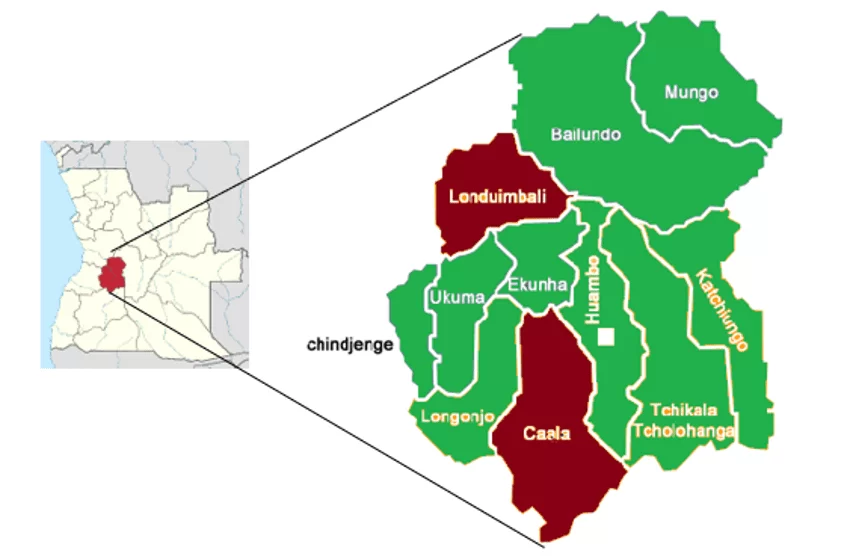
SOCIOECONOMIC CHARACTERIZATION OF THE STUDY AREA
Figure 2. Percentage distribution of the resident population by municipality in huambo province
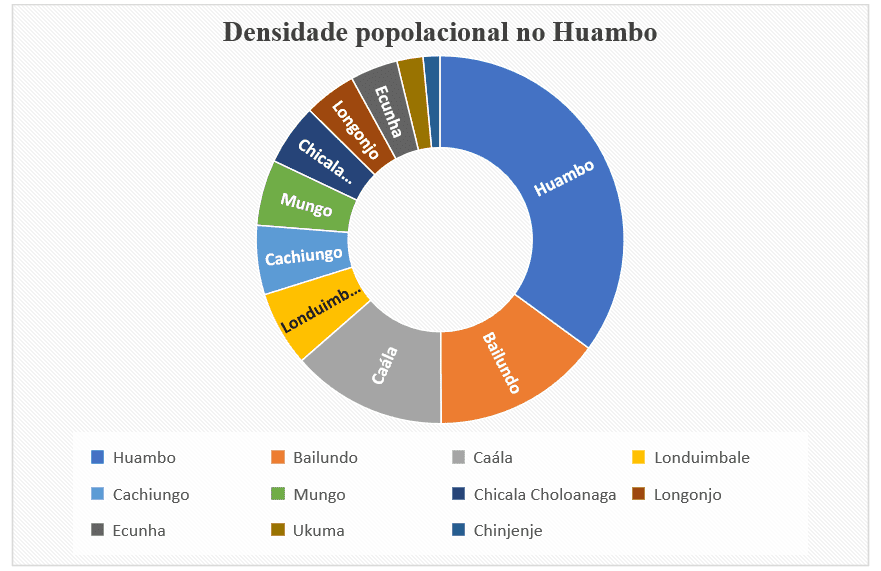
Source: Adapted (INE, 2014).
According to the INE (2014), and as can be seen in the previous figure, the municipalities of Caála and Londuimbale constitute the third and fourth most populous, surpassed by the headquarters municipalities (Huambo) and the Bailundo.
Among the various activities developed by huambo’s citizens, agricultural production stands out, based on the production of corn (Zea mays L.), beans (Phaseolus vulgaris) and other vegetables that serve as a food base (SARDINHA, 2008).
The results of agricultural activity have harmonised growth and benefited the poor in both local and urban rural communities, providing them with more food and raw materials at low prices and reducing poverty through growth in labour productivity and employment opportunities in rural areas as a result of work (LOTE, 2015). The extent of the area explored by peasants, in a phased way, varies from 500 m2 to 6 there, where the main workforce comprises the family workforce. In these communities, people are also small coal trees totally dependent on the forest. And even after the slaughter of coal, they continue to explore the land irrationally with different types of very rudimentary agricultural crops (MALENGUE, 2019).
Coal production has stimulated the generation of jobs in local communities, lacking efficient technologies so that it is produced in a sustainable way (MANICO et al., 2020).
METHODOLOGY
The work was developed in small groups consisting of men, women, young people and children, in the different villages that make up the sensitized communities, using an adaptation of habermas’ communicative action methodology on learning in times of Covid-19. In this, community members behave like a public body when they communicate in a restricted way on matters of general interest (CANCIAN, 2020). In this methodology, the system is understood as the social sphere governed by self-regulated mechanisms such as the market and administrative power, while the world of life is seen as the sphere regulated by the search for understanding through linguistically mediated procedures and encompasses three structural components: culture, society and the person (ALVES et al., 2020). Social distancing was also used, a crucial method to prevent the circulation of contagious diseases such as Covid-19, since these can be transmitted through contact with droplets of coughs and sneezing, or surfaces contaminated by these droplets (WHO, 2020).
RESULTS AND DISCUSSION
As a result of this activity, 26 villages that make up the two communities were sensitized, with a total of 2275 people being covered, including men, women, adolescents and children of various age groups, as can be seen in the following table. The activity is of paramount importance, because it is vulnerable people to contract the disease due to lack of information and the basic means of biosecurity.
As can be seen in table 1, there were disparities in gender participation, both in adults, as well as in children and adolescents.
In the villages that make up the sector or community of Cachindongo, the largest number of the adult population was men, with 271 individuals, which corresponded to 55 % of the total number of participants (see Figure 3). The results found in this community correspond to the tendency of active participation of men in several studies in communities similar to that of Cachindongo and is often justified by the fact that women have multiple tasks, allied to the inferiority complex in relation to men (SANGUMBE et al., 2020).
Table 1. Total participants in the awareness activity against covid-19, by gender and age group. All those who are 18 years of age or older were considered adults.
| Sector of Cachindongo, Commune of Cuima, Municipality of Caála, Huambo | |||
| Designation | Male | Female | Total |
| Children and adolescents | 662 | 590 | 1252 |
| Adults | 271 | 221 | 492 |
| Total by gender | 933 | 811 | 1744 |
| Bonga Sector, Alto Hama Commune, Londuimbale Municipality, Huambo | |||
| Designation | Male | Female | Total |
| Children and adolescents | 177 | 186 | 363 |
| Adults | 70 | 98 | 168 |
| Total by gender | 247 | 284 | 531 |
Source: author.
In the Bonga sector or community, the behavior regarding adult participation was slightly different, since the number of women was 98 individuals, of the 168 present, which corresponded to 58% of the total participants.
The previous trend may be justified by the fact that some villages in the community of Bonga are closer to the urban center, in this case the village of Alto-Hama and the national road 208 that connects the northern provinces to the South Center of the country, which makes them more participatory and emancipatory women, compared to the villages of Cachindongo that are very distant , both the national road and urban centres.
Figure 3. Difference in percentage of adult participation in the communities of Bonga and Cachindongo
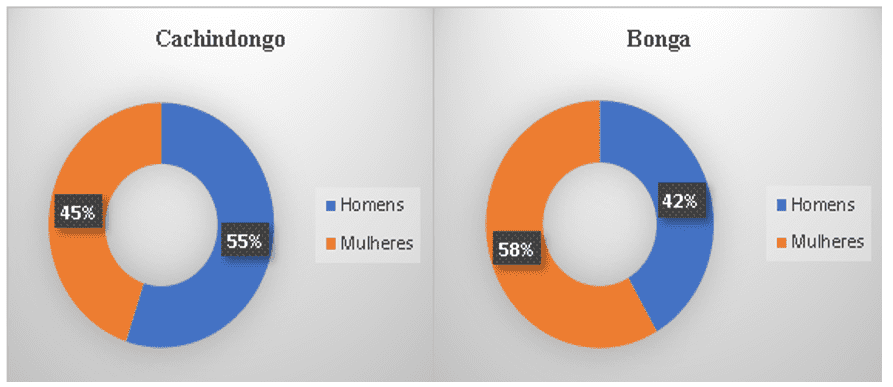
Figure 4. Illustration of small groups created while raising awareness in the various villages that make up the communities of Bonga and Cachindongo.
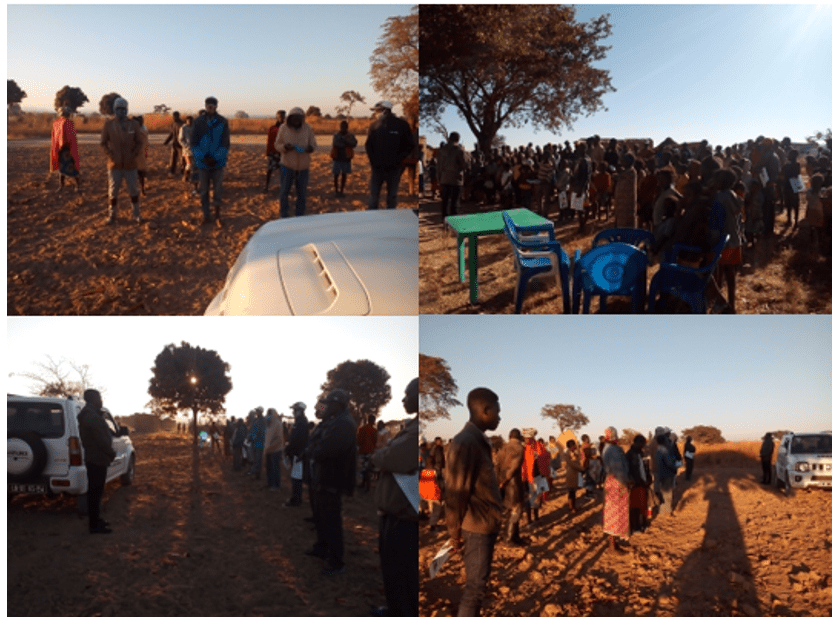
As for children and adolescents, they also appeared in bulk and in a higher number when compared to adults. On the one hand, they were unable to go to school their main activity, but also because they noticed a willingness to know the main symptoms and measures to prevent the pandemic that has been decimated thousands and thousands of individuals regardless of age group.
Figure 5. Difference in percentage of the participation of children and young people in the communities of Bonga and Cachindongo
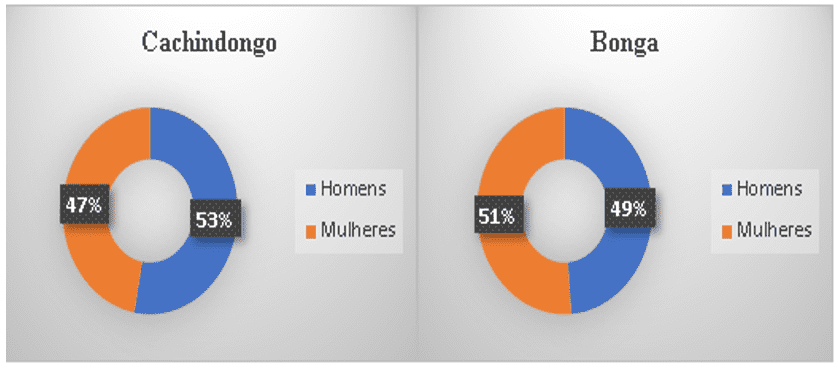
Source: author.
In the community of Cachindongo of the 1252 children and adolescents who participated in the sensitization act, the largest number were also men, as happened with adults, having constituted 53% of those present, as can be seen in Figure 5. The behavior of the participation of children and adolescents in Bonga was also similar, as with adults, since of the 168 participants, 98 were female, which corresponds with 51% of the overall number.
THANKS
To the Ministry of Culture, Tourism and Environment and the United Nations Development Program, for financing the proposal for Strengthening Forest Management in the communities of Bonga and Cachindongo presented by the consortium between the University of Córdoba and the Faculty of Agrarian Sciences of the José Eduardo dos Santos-Angola University, as part of the Sustainable Charcoal Project in Angola on a Value Chain approach. Another yes, to thank the management of the Faculty of Agrarian Sciences for the logistical support, without which it would not be possible to comply with the objectives recommended.
CONCLUSIONS
A total of 2,275 individuals were sensitized to prevention and care with the Covid-19 pandemic, including men, adolescent women and children in the communities of Bonga and Cachindongo.
Regarding the awareness and depending on the distance that between the two communities of urban centers, together with the lack of media such as radio and television, the sensitized knew almost nothing about the pandemic of covid-19, its symptoms and measures to prevent it.
The percentage of participants was not uniform in both communities, with a higher participation of females in Bonga when compared to the community of Cachindongo.
BIBLIOGRAPHICAL REFERENCES
ALVES, J. M., CABRAL, I. (2020). Ensinar e aprender em tempo de COVID 19: entre o caos e a redenção. : Porto: Faculdade de Educação e Psicologia da Universidade Católica Portuguesa.
CANCIAN, R. (12 de Março de 2020). Jürgen Habermas – a teoria sociológica – O surgimento da esfera pública. Obtido em 23 de Dezembro de 2020, de Pedagogia & Comunicação.
DGS. (20 de Dezembro de 2020). https://covid19.min-saude.pt/. (Direção Geral da Saúde) Obtido em 21 de Dezembro de 2020
DW. (20 de Dezembro de 2020). (DW) Obtido em Dezembro de 2020, de Covid-19 em Angola: https://www.dw.com/pt-002/covid-19-em-angola/t-52892758
INE. (2014). Recenseamento geral da população e da habitação de Angola . Launda: INE.
INE. (2020). Obtido em 20 de Dezembro de 2020, de Instituto Nacional de Estatistíca: https://leadershipbt.com/INE/
LOTE, E. R. (2015). Ezequiel Rodrigues Lote. Porto: Universidade Portucalense.
MALENGUE, A. S. (2019). Sensibilização ambiental das comunidades de Cachindongo e Bonga na Província do Huambo. Revista Órbita Pedagógica, VI.
MALENGUE, A. S., HOSSI, A. J. (2019). Percepção ambiental dos diferentes complexos turísticos do município do Huambo. Revista digital de Medio Ambiente “Ojeando la agenda”, pp. 30-49.
MANICO, J. B., LEONIDO, L., GOUVEIA, L. B. (2020). Projecto Carvão Vegetal: Um projecto de Gestão ambiental com o uso dos briquetes nas comunidades urbanas e periurbanas em Angola-Huambo. Revista internacional de Ciência, tecnologia e sociedade, III(2), pp. 1-37. doi:https://doi.org/10.37334/ricts.v3i2.33
OMS. (2020). Brote de enfermedad por coronavirus (COVID-19): orientaciones para el público. OMS. Obtido em 23 de Dezembro de 2020, de https://www.who.int/es/emergencies/diseases/novel-coronavirus-2019/advice-for-public
OMS. (14 de Dezembro de 2020). https://www.who.int/es. Obtido em 14 de Dezembro de 2020, de https://www.who.int/publications/m/item/weekly-epidemiological-update—14-december-2020.
ONU . (2019). Relatório de Desenvolvimento Humano 2019 destaca desigualdades. PNUD Angola. Luanda: PNUD-Angola. Obtido de https://onuangola.org/pnud-relatorio-de-desenvolvimento-humano-2019-destaca-desigualdades/
SANGUMBE, L. M., HOSSI, C. (Novembro de 2020). Importancia de los recursos forestales de Miombo para las comunidades de Vinte Sete, Huambo-Angola. Revista digital de Medio Ambiente “Ojeando la agenda”, pp. 18-33.
SARDINHA, R. M. (2008). Estado, dinâmica e instrumentos de política para o desenvolvimento de recursos lenhosos no município da Ecunha, Angola. Lisboa: MVF – Instituto Marquês de Valle Flôr. Obtido de https://dokumen.tips/documents/desenvolvimento-dos-recursos-lenhosos-ecunha.html
SILVA, E. A. (2011). Tradição e identidade de género em Angola: ser mulher no mundo rural. Revista Angolana de sociologia(8), pp. 21-34. doi:https://doi.org/10.4000/ras.508
VERGARA, S. C. (2008). A resiliência de profissionais angolanos. Revista de administração pública(42), pp. 701-18. Obtido de https://www.scielo.br/pdf/rap/v42n4/a04v42n4.pdf
ZAU, F. (2002). Angola: Trilhos para o desenvolvimento. Lisboa: Universidade Aberta. Obtido de https://repositorioaberto.uab.pt/bitstream/10400.2/436/1/ANGOLA-Trilhos31-105.pdf.pdf
[1] PhD student in Environmental Engineering – Higher Institute of Agronomy, University of Lisbon-Portugal. Master’s degree in advanced technologies for agroforestry development from the Higher Technical School of Agrarian Engineering, University of Valladolid- Spain. Graduated from the Faculty of Agrarian Sciences of the University José Eduardo dos Santos- Angola.
Submitted: January, 2021.
Approved: January, 2021.
